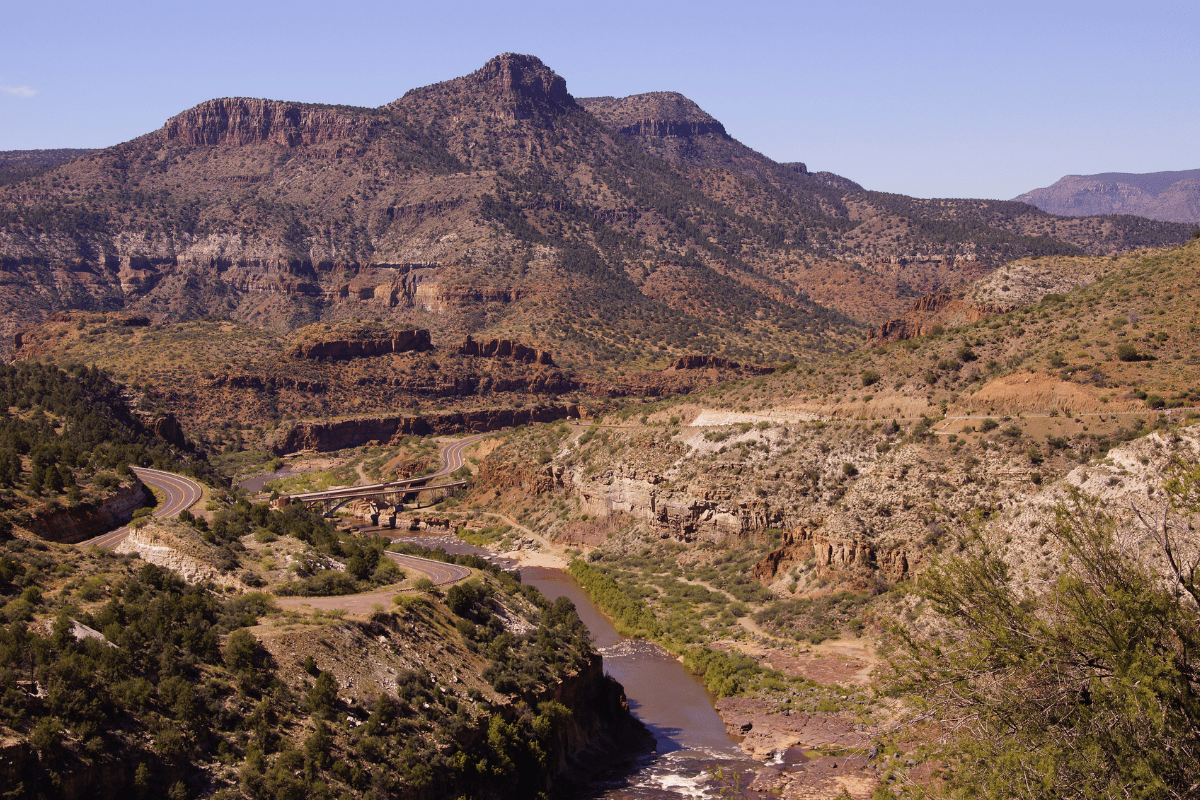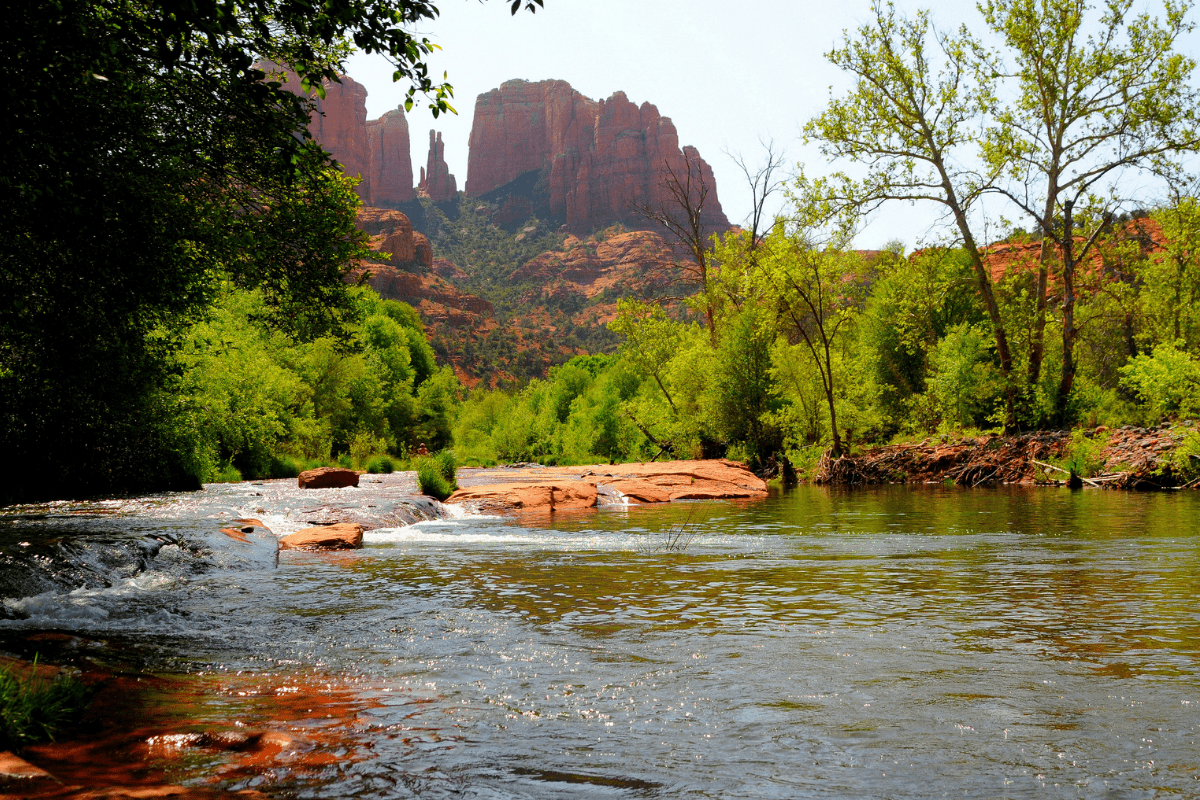Right now, someone is kayaking past 1.4-billion-year-old granite formations in Prescott while another paddler floats beneath London Bridge (yes, the actual one) in Lake Havasu. Meanwhile, a group navigates emerald-green waters below Hoover Dam where the Colorado River stays a constant 55°F even when it's 115°F on shore. Welcome to Arizona kayaking, where nothing is quite what you expected.
The surprisingly accessible crowd-pleasers
Let's start with the destinations that won't require you to mortgage your house for gear or spend three years training with Olympic athletes. These spots welcome everyone from "I've never held a paddle" beginners to "I own seven kayaks" enthusiasts.
Lake Havasu brings the beach vibes (with a British accent)
Lake Havasu absolutely dominates Arizona's water recreation scene, pulling in 547,186 visitors in 2022 alone. That's more people than live in Tucson, all coming to paddle around a genuine London Bridge. Yes, the actual bridge from 1831, reconstructed stone by stone in the Arizona desert because why not?
The lake spans 29.1 square miles with 400 miles of shoreline, which means even on busy weekends, you can find your own little cove. Water temperatures hit that sweet spot of 75-87°F in summer, though fair warning: air temperatures can reach 110°F, turning your car into a mobile pizza oven while you're out paddling.
Rotary Park near the bridge offers protected waters perfect for first-timers who'd rather not immediately swim with their kayak. Once you've got your sea legs (lake legs?), the 14-mile Topock Gorge section delivers what locals call the "Mini-Grand Canyon" experience. Towering rock walls, narrow passages, and significantly fewer international tourists than the actual Grand Canyon.
Getting on the water will cost you $20-25 per vehicle for state park entry. Launch from Lake Havasu State Park's three ramps if you brought your own boat, or hit up AZ Wacko Kayak Rentals for all-day rentals with shuttle service included. Just know that state park concessionaires require a $300 deposit, presumably because someone once tried to paddle to California and never came back.
The Salt River delivers wild horses and mild rapids
Nothing quite prepares you for seeing wild horses while kayaking in the desert. The Lower Salt River hosts 300-500 wild horses roaming a 20,000-acre corridor, and they're absolutely magnificent when they come down to drink in the early morning light.
The most popular 12-mile stretch runs from Water Users Recreation Area to Granite Reef Dam. The water stays refreshingly cool at 50-70°F year-round, which feels amazing when it's 115°F outside but slightly shocking when you first fall in… I mean, if you fall in. Which you probably won't. But maybe bring a change of clothes.
Most of the river offers Class I rapids that your grandma could handle (assuming your grandma is reasonably adventurous). Two spots amp things up slightly:
- Snaggletooth Rapid (half mile from launch)
- Pinball Alley at mile 2.0
Both can reach Class II when flows increase, which in kayaking terms means "exciting but not terrifying."
Wildlife viewing peaks during the two to three hours around sunrise and sunset at spots like Coon Bluff and Phon D Sutton. Remember to maintain a 50-foot distance from the horses, both for their safety and because wild horses can be unpredictable. They're beautiful, not domesticated.
You'll need a Tonto Pass at $8 daily or $80 annually. Arizona Hiking Shack rents singles for $35 and doubles for $45 daily, while REI Adventures offers river delivery with shuttle service for an extra $15. Check USGS gauge 09502000 for flow rates… optimal conditions run 500-1500 cfs.
Verde River serves up variety for every skill level
The Verde River can't make up its mind what it wants to be, which works out great for paddlers. The White Bridge to Beasley Flats section offers 12 miles of gentle floating that won't scare away your nervous friend who "doesn't do water sports." Launch coordinates at 34.753082°N, 112.022116°W include actual facilities, because nobody wants to start an adventure searching for a bush.
For something different, Verde Adventures runs "water-to-wine" tours. Morning paddle, afternoon wine tasting. Genius marketing, really. The Verde River Adventure Center offers multiple tour options, and unlike many Arizona waterways, most Verde sections don't require permits. It's like the river wants you to visit.
The iconic desert lake experiences
Some destinations require a bit more planning but deliver those Instagram moments that make your coworkers question their life choices.
Lake Powell persists despite its challenges
Lake Powell sits 126 feet below full pool as of 2025, running around 3,571 feet elevation. Before you panic, that still leaves 2,000 miles of shoreline to explore. The lake's like that friend who lost weight but still has plenty of personality.
Water temperatures range from a pleasant 75-85°F in summer to a "nope" inducing 41-45°F in winter. The crown jewel experience? Kayaking to Antelope Canyon, where sandstone walls twist skyward in ways that make you question physics. Guided tours run $130+ per person, but you literally paddle into a slot canyon. Your Instagram will thank you.
Three main launch points serve different crowds:
- Wahweap Marina (busiest, full facilities)
- Antelope Point (quieter, closes below 3,558 feet)
- Lone Rock Beach (primitive, locals' favorite)
Mornings typically offer glass-like conditions, but afternoon microbursts during monsoon season can turn the lake into a washing machine. The National Park Service detected harmful algal blooms near Antelope Canyon in July 2025, so maybe don't drink the water. Actually, never drink the water. That's just good life advice.
Watson Lake proves size doesn't matter
Near Prescott, Watson Lake earns its title as "America's best small lake for paddling". At just 55 acres, it's surrounded by 1.4-billion-year-old granite formations that create a maze of hidden coves and passages. The no-wake zone keeps things peaceful, though mercury contamination means you should stay in your kayak. Think of it as motivation not to tip over.
Adventures that require commitment (and sometimes lawyers)
Some Arizona paddling experiences demand more than just showing up with a kayak and a sense of adventure.
Black Canyon below Hoover Dam combines history with hot springs
The Black Canyon Water Trail stretches 30 miles from Hoover Dam to Eldorado Canyon, maintaining a constant 52-55°F water temperature year-round. That's cold enough to make you question your life choices but perfect for those 115°F summer days.
Here's the catch: you can only launch through authorized commercial outfitters. Fifteen companies hold permits, with just three launches daily at 7am, 8am, and 9am, maximum 15 boats per launch. It's like trying to get restaurant reservations, but wetter.
Tours run $70-150 per person and include mandatory safety equipment plus transportation through the security zone. Because paddling below Hoover Dam without permission is apparently frowned upon by federal authorities.
The payoff? Emerald Cave creates an otherworldly green glow when sunlight hits just right. Natural hot springs like Gold Strike and Sauna Cave offer warming stations along the cold river. Desert River Outfitters and Evolution Expeditions lead quality tours, and Sundays and Mondays operate motor-free for those seeking serenity.
Grand Canyon demands expertise and extreme patience
The Colorado River through Grand Canyon represents the ultimate Arizona kayaking challenge. You'll need Class IV whitewater skills minimum and a reliable combat roll, which is kayaker speak for "you better know how to not die."
The permit system works like this: apply in February for the following year, pay a $25 non-refundable fee, and if selected, cough up a $400 deposit. Most people wait multiple years. It's basically the Burning Man of kayaking, minus the art installations and plus more potential drowning.
For those preferring guides, Arizona Raft Adventures offers kayak support trips running 6-18 days at $2,500-5,000+ for the full 277-mile journey. Water temperatures hover at 46-50°F year-round, cold enough to make hypothermia a real concern. Rapids like Lava Falls and Crystal have humbled many experienced paddlers. This isn't a "hold my beer" situation.
Hidden gems worth the detective work
Apache Lake rewards those who venture far
Apache Lake spans 25,000 acres about 65 miles east of Phoenix via the Apache Trail. It's the least crowded major Phoenix-area lake, probably because the drive includes sections that make passengers question their driver's sanity. Crystal-clear water reveals ancient petroglyphs on canyon walls, and secluded coves inaccessible to motorboats offer legitimate solitude.
Lynx Lake delivers mountain vibes
At 5,500 feet elevation near Prescott, Lynx Lake surrounded by Ponderosa pines offers mid-80s summer temperatures when Phoenix resembles the surface of Mercury. It's small, peaceful, and absolutely nothing like what people expect from Arizona.
Essential planning to avoid becoming a cautionary tale
Let's talk safety, because 85% of kayaking fatalities involve drowning, and only 22% of victims wear life jackets. Arizona law requires Coast Guard-approved PFDs for everyone, with kids 12 and under required to wear them constantly.
Monsoon season changes everything
From June 15 to September 30, Arizona's monsoon delivers 40-50% of annual precipitation through daily afternoon thunderstorms. These aren't gentle spring showers… they're violent, sudden, and create flash flooding in previously dry washes. Morning paddles generally encounter calm conditions, while afternoons turn lakes into choppy messes.
Water temperature varies wildly
Cold water locations requiring wetsuits:
- Black Canyon: 52-55°F constant
- Grand Canyon: 46-50°F year-round
- Salt River: 50-70°F
Warm water spots where you'll actually want to fall in:
- Lake Havasu: 75-87°F summer
- Lake Powell: 75-85°F summer
- Most desert lakes: 80°F+ summer
Check USGS's 163 Arizona gauges for real-time conditions. Because showing up to find your river is actually a dirt road is disappointing.
The bottom line on Arizona paddling
Spring (March-May) and fall (September-November) offer the best overall conditions statewide. Mornings beat afternoons for calm water and wildlife viewing. And yes, those economic impact numbers are real… Glen Canyon alone contributes $540 million annually.
Whether you're seeking Instagram glory at Emerald Cave, hoping to spot wild horses on the Salt River, or training for that eventual Grand Canyon permit, Arizona's waterways support 114,000 jobs while shattering every desert stereotype. Just remember to wear your PFD, check the weather, and maybe don't tell your mother about the Class V rapids until after you've survived them.
The desert has water, and it's spectacular. Who knew?





